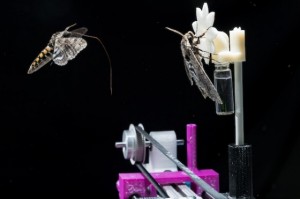Hawkmoths are big, agile insects that hover in place expertly as they feed on nectar at dawn, dusk, and in the evenings. So, not only is it dark out, but the flowers are moving targets thanks to the breeze. Now, with the help of a robotic flower, researchers reveal how hawkmoths forage in the darkness: Their twilight or night vision is exquisitely attuned to flowers swaying in the wind. The findings, suggest that hawkmoth sight and flight evolved to perfectly match the movements of their only source of food.
“There has been a lot of interest in understanding how animals deal with challenging sensing environments, especially when they are also doing difficult tasks like hovering in mid-air,” Georgia Tech’s Simon Sponberg says in a news release. It’s a feat from both a sensory and motor control perspective.
The hawkmoth’s large compound eyes help maximize the amount of light that’s captured. Furthermore, to compensate for dim, changing light conditions, nocturnal and crepuscular (or twilight) flying insects process light over longer times, not unlike a photographer working in low lighting. Slowing down visual processing increases light sensitivity, but it also reduces response times. “Using this temporal strategy is sort of like changing the shutter speed on a camera to increase exposure,” Sponberg tells the Washington Post. “And if you do that with a series of frames, each gets brighter, but also blurrier. It gets harder to see fast things.” Slowing their tiny brains improves low-light vision, but now their tracking lags behind.
So, how are these hummingbird-sized insects able to track wind-tossed flowers when it’s dark? To see, Sponberg and colleagues tempted Manduca sexta hawkmoths with a 3D-printed flower filled with nectar and attached to a robotic arm. They used high-speed infrared cameras to monitor how well the free-flying moths kept their proboscises (or their tongues) in the nectar dispenser. Also, the flower was programmed to move side-to-side at various rates up to 20 Hertz, or 20 cycles per second. Since their wings beat at a rate of 25 strokes per second, that means they’d have to adjust their direction with almost every wingstroke.
The team discovered that in dark, moonlit conditions, the moth’s tracking responses were 17 percent slower compared to brighter, early-dusk light. Furthermore, the hawkmoths had a hard time tracking flowers moving at frequencies higher than 1.7 Hertz. When the team analyzed the movements of five of the moth’s favorite (real) flowers as they blew in the wind, they realized that 94 percent of the flowers’ motions remained below 1.7 Hertz.
“This was an interesting example of how an organism can tune its brain to maintain its ability to gather food,” Sponberg explains. They expected moths to track poorly in low-light conditions. “The moths do suffer a trade-off by slowing their brains, but that trade-off doesn’t end up mattering because it only affects their ability to track movements that don’t exist in the natural way that flowers blow in the wind.”
Their findings suggest the moth and the plants it pollinates co-evolved to provide a perfect match of movement, flight and sight that enables them to perform so well in the dark. “
Dr Sponberg added that a surprising result of the work was seeing how well an animal with a tiny brain can combine dynamic movements with adjusting its brain processes to different light levels. A discovery, that could help the next generation of “micro air vehicles” operate efficiently under a broad range of lighting conditions.
“This is really an extreme behavior, though the moth makes it look simple and elegant. To maneuver like this is really quite challenging. It’s an extreme behavior from both a sensory and motor control perspective,” Dr Sponberg said.
For more information please visit: www.cos.gatech.edu

